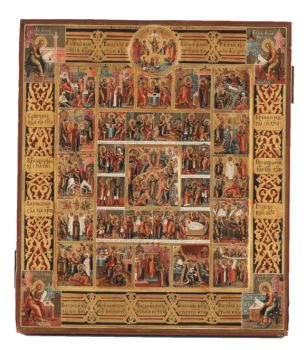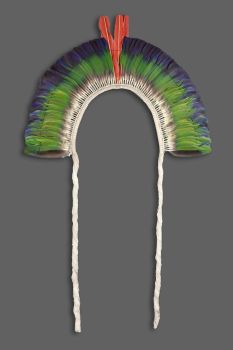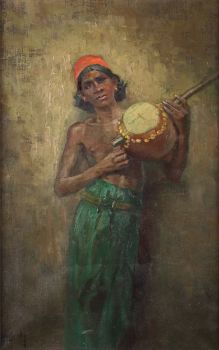A Lakota warrior’s feather headdress North or South Dakota, United States of America 1910 - 1930
Artiste Inconnu
201 cm
Prix sur demande
Zebregs & Röell - Fine Art - Antiques
- Sur l'oeuvre d'artH. 201 cm (incl. standard)
This ritual headdress consists of an assembly of 28 eagle feathers attached to a leather and felt hat using pieces of red fabric from uniforms of the American army or long strips of fabric of English origin exchanged at trading posts.
The feathers belong to the Golden Eagle (Aquila chrysaetos) and are decorated at the end with dyed red horsehair (Equus caballus). The top of the cap is ornamented with bells and fur that are visible between the feathers above the beaded band. A multicoloured beaded band featuring geometric patterns reminiscent of the shape of tepees unfolds at the forehead. The beads came from exchanges with American traders. Furthermore, the headdress has side pendants made of strips of coloured fabric. At the back of the headdress, under the central feather, a beautiful decorative element can be seen: a braided and dyed porcupine quill and a set of brown eagle feathers.
This type of eagle feather headdress was the most important and imposing symbol of prestige for the warriors of the Plains. Only prominent warriors earned the right to wear a full-feather headdress. According to the Lakota, the eagle is the symbol of sacred warrior power. More specifically, the eagle is considered the 'master of the sky and the birds', and its feathers are symbols of bravery and wisdom.
The down feathers, undulating with the slightest breath of air, were seen as a tool of communication with the spirit world. The making of a headdress gave rise to numerous ceremonies and songs celebrating the valour of the warrior for whom the headdress was intended. During the making of the headdress, each time a feather was added, one of the great feats of arms of the warrior was recalled. As such, once the headdress is finished, it constitutes a trophy recalling the many victories of the warrior and, more broadly, of the whole tribe. Within the tribe, only the chiefs and a limited number of men were authorized to wear a war cap. The wearing of the headdress was absolute proof of bravery in battle, and all members of the tribe owed respect to whoever wore it. Today, native leaders present feather headdresses to government officials and politicians to signify a diplomatic relationship.
This headdress was probably brought to Europe by a Lakota tribesman. Several groups of Lakota travelled Europe to perform and showcase their culture. During the expositions, they were often placed in a village-like setting where spectators could view them like in a zoo.
A comparable headdress can be found in the Metropolitan Museum of Art (on loan from the Eugene and Clare Thaw Collection, Fenimore Art Museum, Cooperstown).
Sources:
Marc Petit, Mémoires Indiennes, Champollion Museum, Figeac, 2011
Steve Friesen, Lakota Performers in Europe: Their Culture and the Artifacts They Left Behind, University of Oklahoma Press, Norman, 2017 - Sur l'artiste
Il peut arriver qu'un artiste ou un créateur soit inconnu.
Certaines œuvres ne doivent pas être déterminées par qui elles sont faites ou elles sont faites par (un groupe d') artisans. Les exemples sont des statues de l'Antiquité, des meubles, des miroirs ou des signatures qui ne sont pas claires ou lisibles, mais aussi certaines œuvres ne sont pas signées du tout.
Vous pouvez également trouver la description suivante :
•"Attribué à …." A leur avis probablement une oeuvre de l'artiste, au moins en partie
•« Atelier de …. ou « Atelier de » À leur avis, une œuvre exécutée dans l'atelier ou l'atelier de l'artiste, éventuellement sous sa direction
•« Cercle de… ». A leur avis une oeuvre de la période de l'artiste témoignant de son influence, étroitement associée à l'artiste mais pas forcément son élève
•« Style de … ». ou "Suiveur de ...." Selon eux, une œuvre exécutée dans le style de l'artiste mais pas nécessairement par un élève ; peut être contemporain ou presque contemporain
•« Manière de… ». A leur avis une oeuvre dans le style de l'artiste mais d'une date plus tardive
•"Après …." A leur avis une copie (quelle qu'en soit la date) d'une oeuvre de l'artiste
•« Signé… », « Daté… ». ou « Inscrit » À leur avis, l'œuvre a été signée/datée/inscrite par l'artiste. L'ajout d'un point d'interrogation indique un élément de doute
• "Avec signature ….", "Avec date ….", "Avec inscription …." ou "Porte signature/date/inscription" à leur avis la signature/date/inscription a été ajoutée par quelqu'un d'autre que l'artiste
Êtes-vous intéressé par l'achat de cette oeuvre?
Artwork details
Related artworks
Unbekannter Künstler
Japanese transition-style lacquer coffer 1640 - 1650
Preis auf AnfrageZebregs & Röell - Fine Art - Antiques
Unbekannter Künstler
UITGEBREIDE FEESTDAGENIKOON MET PASSIECYCLUS19th century
Preis auf AnfrageHeutink Ikonen
1 - 4 / 12Unbekannter Künstler
EIN JAPANISCHES MODELL EINES NORIMONO, EINES PALANQUINS1650 - 1700
Preis auf AnfrageZebregs & Röell - Fine Art - Antiques
Unbekannter Künstler
EIN GILT-SILBER SRI LANKAN DOKUMENT SCROLL CONTAINER19th century
Preis auf AnfrageZebregs & Röell - Fine Art - Antiques
Unbekannter Künstler
The Stamford Raffles Secretaires.1800 - 1813
Preis auf AnfrageZebregs & Röell - Fine Art - Antiques
Unbekannter Künstler
A Japanese bronze Hu flower vase, Edo / Meiji, 19th century19th century
Preis auf AnfrageMenken Works of Art
1 - 4 / 24Unbekannter Künstler
Holländer in Miniatur18th century
Preis auf AnfrageZebregs & Röell - Fine Art - Antiques
Unbekannter Künstler
Eine JURUNA TRIBE FEATHER HEADDRESS1900 - 1950
Preis auf AnfrageZebregs & Röell - Fine Art - Antiques
HUGO VILFRED VON PEDERSEN
Gadesanger fra Singapore (Musician from Singapore)1870 - 1959
Preis auf AnfrageZebregs & Röell - Fine Art - Antiques
 Kuratiert von
Kuratiert vonDanny Bree
1 - 4 / 12
















































